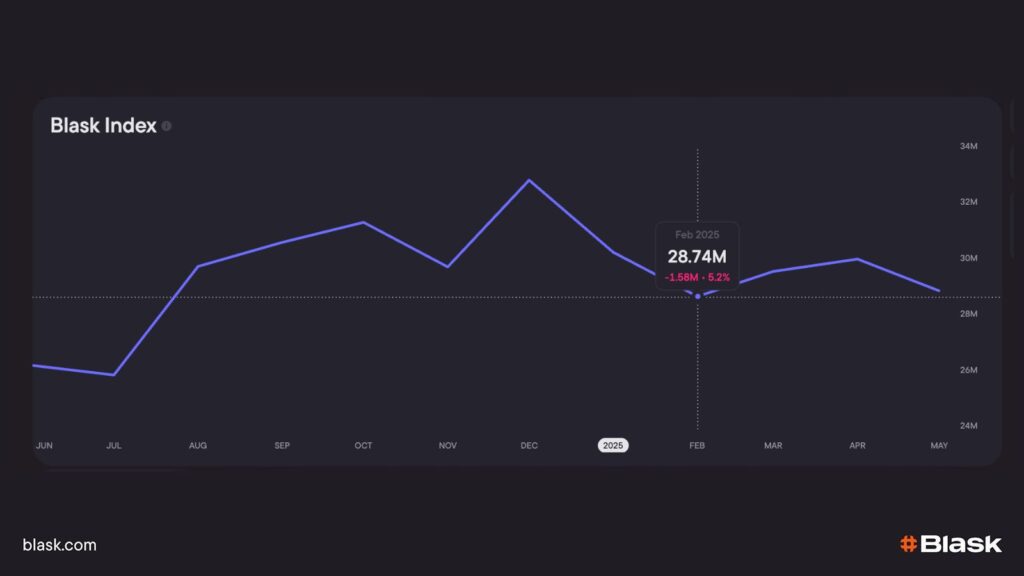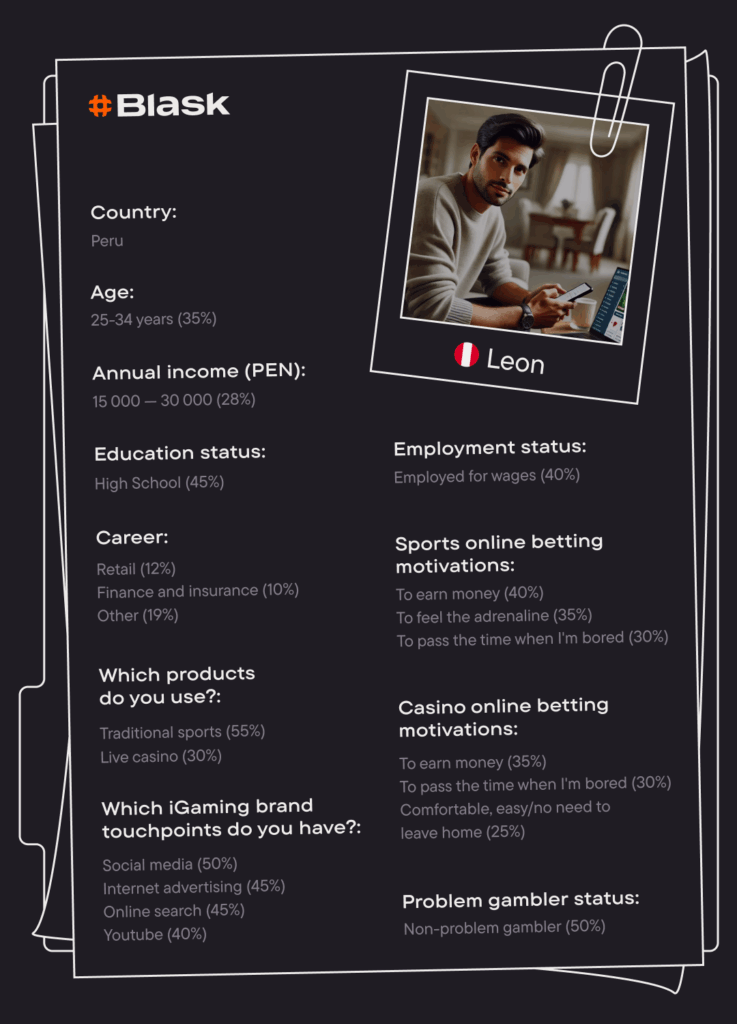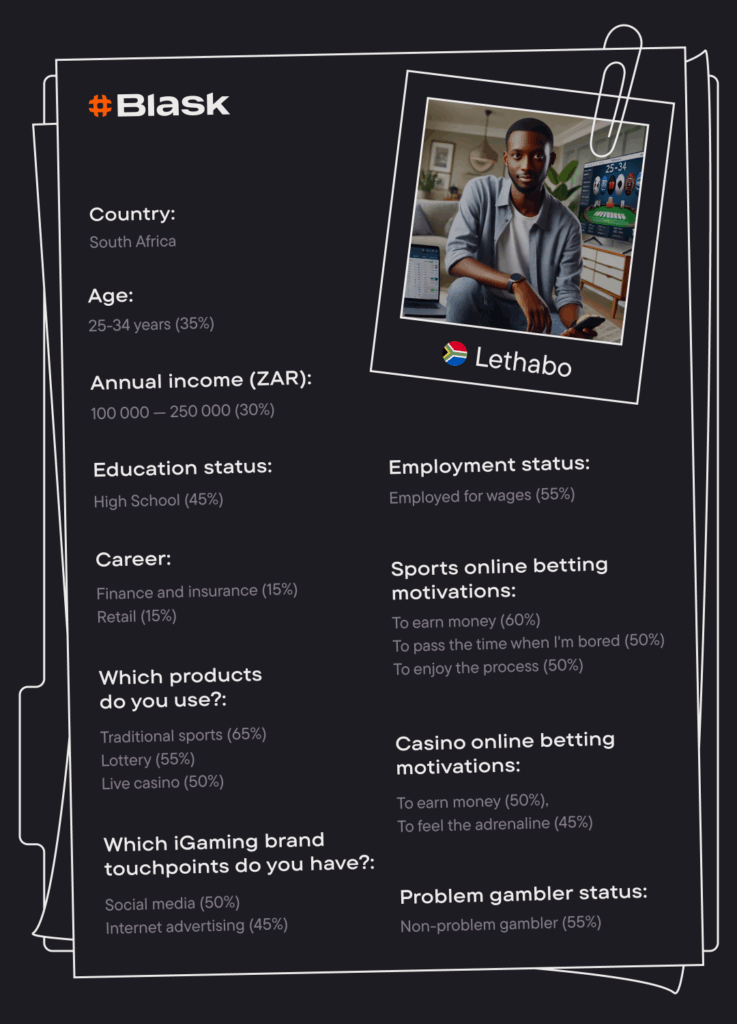
2025 will be the year iGaming finally feels real-time: granular demand data crashes into AI-driven product cycles, game lobbies behave more like TikTok feeds, and regulation stops being the villain and becomes the fuel for new monetisation models.
Below are the five trends our own dashboards are already shouting about — each illustrated with a Blask metric or feature you can track today and cross-linked to deeper reads for your team.
Hyper-granular market intel goes mainstream
What exactly is Blask Index?
Blask Index is Blask’s “share-of-search” barometer: every hour our engine pulls Google search volumes for every iGaming brand, filters out noise words such as “scam” or “login problem,” normalises the clean queries against the country’s total search pool and rescales them into a single headline figure.
The result is an always-on proxy for real market share that has shown ≈95 % correlation with audited revenue data in back-tests.
- Brand level. Each operator receives its own Blask Index curve, so you can see which titles steal attention minute-by-minute.
- Country level. Summing all operators yields a national Blask Index — a live “GDP-style” number for player demand.
💡 Example:
At the first day of IPL 2025 Blask Index surged from 1.60 million on March 21 to 2.39 million on March 22, the opening day of IPL 2025.

📚 Read more: What is Blask Index?
How do you manage Blask Index?
- Pin the widget. Add the hourly Blask Index tile to any dashboard (Brands, Countries or the new Games view) so the number refreshes in-place every sixty minutes.
- Set smart alerts. Define a %-threshold; the moment a brand or market pierces that line, Blask fires Slack/e-mail/webhook notifications so CRM, risk or trading can act instantly.
- Layer baselines. Overlay 7-day, 30-day and 365-day moving averages to see whether a spike is a true anomaly or just weekly seasonality.
💡 Pro tip: Check the YoY or MoM metrics to compare today’s reading with the same day 365 / 30 days ago, turning raw noise into context.
Three ways to use Blask Index right now
| Use case | What to watch | Immediate action |
|---|---|---|
| Live-event hijacking | Hour-by-hour Blask Index during IPL overs or Copa América kick-off | Auto-trigger push offers or odds boosts while the surge is still climbing |
| Campaign proof | Compare the pre-campaign baseline with the in-flight curve; sustained uplift = creative is landing | Extend media budget or clone the message to other regions |
| Strategic sizing | Rank 57 covered countries by YoY Blask Index growth to spot Rwanda-style triple-digit risers | Fast-track licensing & localisation before rivals arrive |
📚 Read more: Build a market-ready iGaming strategy
Acquisition KPIs get de-financialised
What is Acquisition Power Score (APS)?
APS is Blask’s AI-driven gauge of how many new customers your brand should be able to win in the current calendar month, given its share-of-search, media buzz and competitive crowding.
Each month (around the 10-th) Blask publishes a three-tier corridor for every brand and market:
| Band | Meaning | Typical Action |
|---|---|---|
| Better | Head-room a market-leading brand can capture | Press harder – the model says more newcomers are still on the table |
| Average | Mid-pack potential at today’s visibility | Maintain mix; tweak creatives to climb |
| Worse | Minimum newcomers you should reach just by showing up | Diagnose funnels, promo fatigue or licence drag |
APS replaces the legacy first-time-deposit mindset: instead of counting yesterday’s cash, it sets a forward-looking benchmark that is industry-agnostic and refreshed every month, so Boards can talk opportunity, not book-closed revenue.
How to compare APS
| Comparison | What to Look For | Why It Matters |
|---|---|---|
| Month-on-month self-check | Plot this month’s corridor against last month’s. A jump in the whole range = your visibility really grew. | Quantifies the extra newcomers your latest campaign, product launch or sponsorship unlocked. |
| Actual FTD vs. APS band | Map your internal FTDs onto the corridor. Inside green = on-par; above Better = over-performing; below Worse = leakage. | Flags hidden conversion issues (CX, KYC, payments) long before finance month-end. |
| Head-to-head with rivals | Overlay competitors’ APS bands for the same month. | Shows whose sponsorship, influencer push or SEO sprint really pulled share. |
| Historical movers | Use Blask’s archive to spot brands that swung APS after past events. | Reverse-engineer winning tactics before your next big fixture. |
How to use APS in practice
- Feed C-suite KPIs
APS + its revenue twin CEB translate marketing moves into board-friendly “newcomers reachable / dollars capturable” language - Set the baseline
Capture last month’s corridor before your jersey logo goes live. - Measure the lift
When the new APS drops:- Above Better → sponsorship is feeding the funnel: double-down next matchday.
- Inside band → holding steady: refine creatives or on-site CTA.
- Below Worse → urgent fix: pricing, offer or landing flow.
- Slice the surge
Break the APS jump by country, channel or persona inside Blask dashboards to see where the logo resonated. - Benchmark & iterate
If a rival’s corridor vaulted higher during the same tournament, study their placements or influencer mix and adjust before the next game-week.
📚 Deep dive: Ushering in APS & CEB for a New Era of Brand Performance
Games become the new growth frontier
Hyper-competitive sports books have squeezed margin everywhere except the casino lobby. In 2025 the fastest-growing GGR now comes from individual titles — crash games, regional-flavoured slots, instant UPI-friendly content — and you can only catch the wave if you track performance game-by-game, not brand-by-brand.
What Blask Games measures
| Metric | What it captures | Why it matters |
|---|---|---|
| Game Visibility Rank (GVR) | Exact lobby position of a game on every monitored casino (1 = hero tile). | Placement drives 90 %+ of organic clicks; lose the hero row, lose volume. |
| Share of Interest (SoI) | % of all game-related searches a title attracts inside a country. | Lets you spot the next hit before lobby placement reacts. |
| Availability count | # of casinos and # of pages where a game is listed. | Shows distribution gaps to close with BD deals. |
How to read & compare GVR / SoI
- Baseline the fleet
Open the Game View and sort by Avg GVR. Titles sitting above position 25 across most lobbies are already under-performing — flag them for promo rotation. - Isolate risers
Flip to SoI 30-day delta: anything >+20% but still buried in GVR >40 is a sleeper hit — push the studio for exclusivity before competitors notice. - Cross-market scouting
Use the country toggle: a crash title peaking in Brazil often trends in India 4-6 weeks later as UPI bettors chase high-tempo games.


Operator playbook
| Goal | Dashboard Move | Immediate Action |
|---|---|---|
| Fill lobby gaps | Filter by Not-present in-market | License 5 highest-SoI titles missing from your site – prove value with search demand, not gut feel. |
| Win emerging genres | Tag games by Type = Crash / Instant then sort by SoI growth | Run splash promos while CPA is still low; lock banners for the next 30 days. |
| Turbo retention during events | Create an alert on any game whose GVR improves > 5 spots inside an hour | Fire in-game challenges or push-notifications while buzz is live – Blask’s hourly signal beats next-day revenue logs. |
📚 Quick tour: Want to see the Game View in action? Check the step-by-step walkthrough.
Customer Profile – country-level player personas on tap
Blask Customer Profile turns months of expensive market surveys into a two-click dashboard.
Behind the scenes our AI analyses millions of open-source signals to surface age brackets, income bands, education levels, employment sectors, preferred game types and top conversion motives for every monitored country.
That means you can tailor creatives, bonuses and acquisition bids to the reality of who actually plays, instead of betting on stereotypes.
What exactly is in a Customer Profile?


How to work with it
- Slice & compare: toggle multiple countries side-by-side to spot white-space niches (e.g. high-income cricket fans in India vs. low-income fans in Kenya).
- Feed campaigns: export the pre-built segments to your DSP / CRM, then line them up with real-time APS and Blask Index spikes for precision timing.
- Close the loop: after launch, measure uplift in APS (acquisition) and CEB (revenue) for that segment; iterate weekly.
Why it beats DIY research
- Cost: hours, not £25 k focus-groups.
- Granularity: national-scale sample sizes; no more “n=300” error bars.
- Linkage: lives in the same UI as Blask Index, APS & Game dashboards—so audience insight, demand shifts and content performance sit in one decision stack.
📚 Read more: What is Blask Customer Profile.
Brands radar – spot breakout operators before the rest of the market
Blask’s dashboard gives you a single, filterable table for every operator we track (2 500+ and counting). With one glance you can:
| What you can do | How to do it in All Brands | Why it matters |
|---|---|---|
| Rank growth stars in every market | Sort by YoY or MoM Blask Index delta to surface the fastest-moving names across all countries. | Stake’s growth in India is 164.1% |
| Drill into niches | Apply country, licence-type or vertical filters (e.g. crypto sportsbooks, .bet TLDs). | Builds a precise competitor set for pitch decks and M&A target lists. |
| Benchmark newcomers vs. incumbents | See which fresh licences are already stealing share. | Helps product, CRM and VIP teams understand the playbook that’s working right now. |
💡 Success story: Blask’s “All Brands” dashboard has crowned betPawa as Africa’s top iGaming brand, achieving a record 22.24M APS. With a strong mobile-first approach and deep local expertise, betPawa outperforms competitors, proving that advanced analytics drive success in regulated markets.
📚 Read the full story about betPawa.
Blask keeps every metric (Blask Index, BAP, APS, CEB) side-by-side in this view, so growth strategists can jump from interest → acquisition → monetisation without exporting a single CSV.
The takeaway for 2025
Winning next year isn’t about guessing the next big sport or building the flashiest bonus wheel — it’s about reading micro-signals faster than the competition and acting before they refresh their spreadsheets. Blask’s suite (Index → BAP → APS → CEB → Games) is built exactly for that cadence.

